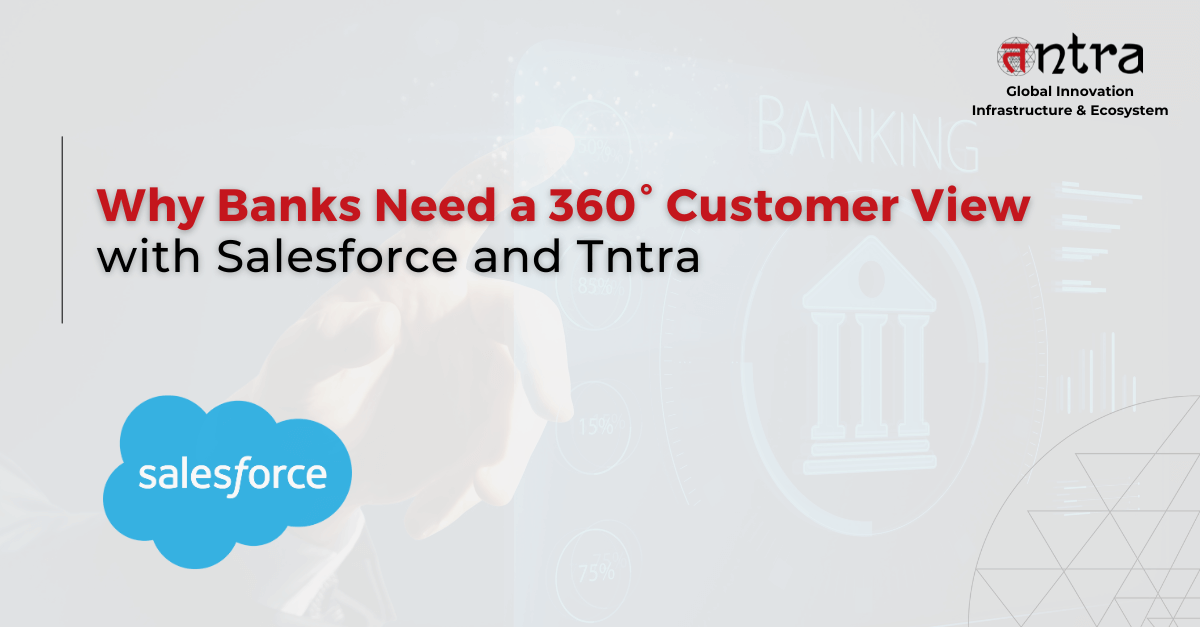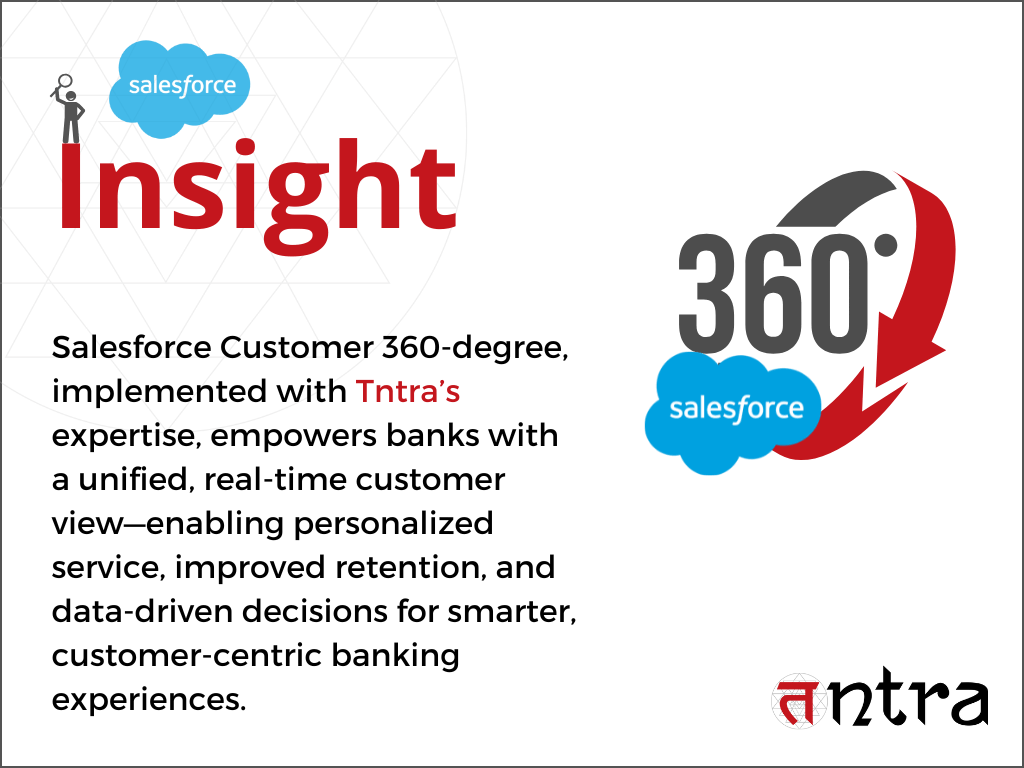
Why Banks Need a 360° Customer View with Salesforce and Tntra
Table of Contents
ToggleIn this blog, we explore how Salesforce Financial Services Cloud provides a 360-degree customer view for the bank, transforming customer interactions from reactive transactional to evolving based on proactive personalized engagement. Discover how banking relationships are changing with real-time customer data, AI insights, and seamless integration. Continue reading to learn more.

Why a 360° Customer View in Banking with Salesforce is Essential Today
Banks aren’t just vaults and spreadsheets anymore—they’re evolving into customer experience hubs. In today’s hyper-connected financial landscape, customer experience in banking is no longer a “nice-to-have”—it’s the competitive edge. Customers now expect more than transactions; they demand personalized experiences, intelligent solutions, and that unmistakable feeling of being understood by their bank.
From a frictionless loan process to timely financial advice, every touchpoint matters.
That’s where the value of a 360-degree customer view in banking comes in.
Imagine seeing your customer’s entire financial narrative in one unified dashboard—their savings behavior, credit card usage, mortgage activity, and even life milestones like a job change or home purchase.
Now imagine acting on that intelligence in real time.
That’s the transformational power unlocked with a 360° Customer View for Banks with Salesforce.
Salesforce Customer 360 empowers banks to shift from reactive service to proactive, personalized engagement, driven by AI and advanced customer relationship management for banks.
According to McKinsey, banks using AI in banking CRM have achieved a 10–15% increase in sales conversions and a 20–30% boost in customer satisfaction—proof that data-driven personalization works.
Because ultimately, it’s not about having more data—it’s about making smarter, more human connections. And Salesforce for financial institutions makes that possible like never before.
What is a 360-Degree Customer View in Banking?
A 360-degree customer view is your bank’s real-time lens into every facet of your customer’s financial world. It goes beyond knowing balances or recent transactions—it’s about merging transactional, behavioral, and demographic data into one intelligent, actionable profile.
Here’s what fuels that insight:
- Transactional Data: Financial behaviors like spending, payments, loan applications.
- Behavioral Data: Digital interactions such as website visits, app usage, and click patterns.
- Demographic Data: Age, income, life stage—context that humanizes the numbers.
When banks combine these data streams, they move from responding to predicting customer needs. That’s the strength of the Salesforce Customer 360 Data Model—it unifies customer data across all touchpoints for a truly integrated banking CRM solution.
With Salesforce, banks can deliver hyper-personalized experiences, like guiding users toward savings goals or offering pre-approved loans exactly when needed.
And yes, Salesforce Customer 360 pricing is flexible enough to scale with your institution’s growth.
📊 FACT: 70% of customers say a company’s ability to understand their unique needs directly influences loyalty.
Armed with real-time customer data, predictive insights, and Salesforce consulting services, banks move beyond servicing—they connect.
The Role of Salesforce in Creating a 360° Customer View
Salesforce is a giant in customer relationship management for banks — a custom platform that bridges the gap between financial institutions and their customers. With Salesforce for financial institutions, banks can build both personalized and data-driven customer engagement strategies that improve connectivity and trust.
Key Features of Salesforce Enabling 360° Customer View
- Data Aggregation: Salesforce brings together customer data from different touchpoints—whether transactional, online, or demographic—into a single, unified system. This ensures well-informed, contextually relevant interactions at every customer-facing touchpoint and enables a 360-degree customer view in banking.
- Analytics Tools: Empowering banks with robust customer insights and analytics, Salesforce helps decode complex data patterns, anticipate customer needs, and tailor services accordingly. Not only does this increase satisfaction, but it also cultivates long-term loyalty.
- Automation: Salesforce’s automation capabilities streamline operational tasks—like loan underwriting, KYC updates, and deposit rate approvals—allowing banking professionals to focus on strategic decision-making and relationship-building. This also enhances operational efficiency in banking CRM.
(Source)
Case Study: Ponce Bank Enhances Experience with Salesforce 360
Ponce Bank, a community-centric institution, struggled with customer data fragmented across 54 systems. With the rollout of Salesforce Financial Services Cloud, they achieved a real-time, 360-degree view of each customer. This transformation enabled:
- Improved Operational Efficiency: Automation across sales and operations minimized manual workloads and accelerated service delivery, showcasing the impact of Salesforce CRM for banking.
- Personalized Customer Service: With comprehensive profiles, Ponce Bank delivered personalized financial guidance, deepening customer relationships and boosting satisfaction.
“With Salesforce, we’ve been able to grow and touch more people and more businesses than we ever thought possible.” — Carlos Naudon, CEO, Ponce Bank
This turnaround highlights how Salesforce is redefining the banking customer experience—proving that with the right digital transformation tools, banks can not only meet but exceed expectations
Benefits of a 360° Customer View for Banks
Many institutions are adopting banking CRM solutions to gain a 360-degree view of customers, unlocking key advantages that drive both growth and customer satisfaction.
- Enhanced Customer Experience
Comprehensive insights allow banks to offer services tailored to individual financial needs. This level of personalization in banking goes beyond mere convenience—it significantly boosts engagement. In fact, 72% of customers consider personalized service “highly important.” - Improved Customer Retention
By aligning offerings with customer behaviors and preferences, loyalty naturally grows. 65% of businesses that invest in personalization report increased customer retention—proving that a 360-degree customer view in banking is more than just a tech upgrade; it’s a loyalty driver. - Data-Driven Decision Making
Through advanced customer analytics in banking, institutions can identify profitable segments, assess risk, and develop smarter strategies. This not only enhances financial services CRM but also powers innovation in customer engagement strategies for banks. - Operational Efficiency
A unified view enables seamless collaboration across departments, reducing inefficiencies and enabling faster service delivery. The result? A leaner, smarter bank that directs focus toward value-added activities that enhance the banking customer experience. - Leveraging AI in Banking CRM
AI amplifies these benefits by automating tasks, forecasting customer needs, and providing predictive insights. AI in banking CRM empowers institutions to remain agile and competitive in an evolving financial landscape.
With the power of Salesforce Customer 360, banks can deliver personalized, predictive, and efficient services that build trust, foster growth, and ensure long-term success.
Explore the Complete Guide to Salesforce Financial Services Cloud to discover how your bank can unlock deeper customer insights, streamline operations, and drive personalized engagement at scale.
Challenges in Implementing a 360° Customer View
Implementing a 360-degree customer view in banking is a difficult endeavor, but there are challenges that institutions need to overcome to make it work.
- Data Silos: Most banks have different systems and software set up in various departments, resulting in disjointed customer data. Such silos make it difficult to create a consolidated customer view necessary for personalized customer engagement strategies for banks.
- Legacy Systems: Many banks still rely on outdated technology infrastructures that cannot easily adapt to support modern customer data analytics techniques. The task of providing a complete view of customers is extremely difficult because these systems and processes are often deeply embedded and resource-consuming to upgrade—hindering efforts like Salesforce Customer 360 implementation.
Importance of Change Management and Staff Training
To implement a data-driven banking strategy, banks need to not only upgrade their technology but also adapt their organization’s culture for transition. Change management engages staff in why change is good and the process, which helps cultivate acceptance and action and lets staff know what is being done to them and helps facilitate acceptance and movement/forwarding of action. Through data-based insights in banking, comprehensive training programs enable employees to use new systems to satisfy their customers.
Strategies for Successful Implementation
- Data Integration:
Aggregate the data across customer data integration frameworks. Minimize unnecessary fields and maintain consistency between your technology platforms to improve the quality of your data. This streamlining improves system performance and supports core features of Salesforce for financial institutions. - Utilizing AI and Analytics:
Understand customer interaction and preferences better by integrating AI in banking CRM. AI can analyze vast amounts of data to discover patterns that can give rise to predictive analytics and formulate proactive approaches to customer relationship management for banks. - Continuous Improvement:
Set up systems for periodic evaluation of the initiatives put in place. Gather and analyze customer feedback to discover improvement opportunities. This iterative approach ensures that strategies for implementing customer-centric practices in banks remain effective and responsive to evolving customer needs.
Innovative banks understand this and will spare no expense to ensure they execute such a strategy—even though it is fraught with initial difficulties that include proper data capture technology, time loss from manual data entry, and the need for a unified vision.
Future Trends in Banking and Customer Experience
As machine learning (ML), artificial intelligence (AI), and predictive analytics continue to advance, the banking industry is undergoing significant changes. These technologies enhance the 360-degree customer view, enabling Salesforce for financial institutions to deliver personalized and convenient service.
Open banking APIs are revolutionizing how banks connect with their customers, shifting the focus from transactions to personalized, seamless experiences. By enabling secure data sharing between banks and third-party apps, APIs allow users to access services like real-time budgeting, account aggregation, and instant payments — all from a single platform.
This transformation empowers customers to manage their finances with greater control and convenience. At the same time, banks gain valuable insights that help them deliver more relevant, tailored solutions. Whether it’s personalized investment advice or instant loan approvals, API-driven services enhance engagement and build trust.
Banks are no longer just financial service providers; they’re evolving into digital platforms that integrate effortlessly into daily life. With fintech collaboration and API innovation, financial institutions can create value-added customer experiences that deepen relationships.
In this new era, customer expectations are high — and open banking makes it possible to meet and exceed them. Through secure, user-focused solutions, APIs are shaping the future of banking by fostering stronger, smarter, and more connected customer interactions.
Emerging Trends in 360° View
- Artificial Intelligence and Machine Learning:
AI and ML algorithms are used to analyze extensive datasets with customer information to discover patterns in preference, purchases, and financial behavior. From data, banks can also proactively predict demand and offer tailored products and services through platforms like Salesforce Customer 360. - Predictive Analytics:
Using historical data, predictive analytics allows banks to forecast customer behavior—whether purchasing a new financial product or leaving the institution. The result is improved customer retention and satisfaction, contributing to stronger customer engagement strategies for banks.
Transforming the Future of Banking Customer Relationships
The combination of these technologies and Salesforce consulting services is providing a more personalized banking experience. AI chatbots, for instance, can offer immediate customer service, while predictive models can advise on financial products aligned with individual goals. This level of personalization will help banks build stronger relationships and foster long-term loyalty among their customers.
Additional Case Studies: How Tntra Put this Into Practice
Salesforce Financial Services Cloud, implemented with the help of Tntra, a software product engineering company, led to the transformation of a major financial institution. This powerful Salesforce Financial Services Cloud solution increased customer satisfaction by 27% and employee productivity by 24% by streamlining operations and improving Salesforce-based customer engagement through a unified, 360-degree customer view.
Embracing the Future with Salesforce Customer 360
The 360-degree customer view in banking is more than a technological enhancement—it’s a complete mindset shift. It’s about truly seeing your customers, understanding their financial journeys, and proactively anticipating their needs—even before they ask. This clarity and connection are what distinguish modern, customer-first banks.
At the center of this transformation? Salesforce Customer 360. From advanced data integration to AI in banking CRM, Salesforce delivers the kind of digital transformation solutions that enable banks to move fast, think smart, and serve better.
Whether you’re a large institution or a nimble community bank, tools like Salesforce Financial Services Cloud, paired with expert Salesforce consulting services and software product engineering companies, can help you unlock next-level customer engagement and operational efficiency.
💡 88% of customers say the experience a company provides is as important as its products or services.
The future of finance is personal, predictive and data-driven. It’s time to welcome the change. Banks must adopt these strategies with the help of the right software product engineering services, not only to be smart, but also to build resilience.
FAQs
What is the purpose of Salesforce Customer 360?
Salesforce Customer 360 integrates data across departments—sales, service, marketing, and beyond—to provide a single, unified customer profile. This enables cross-functional teams to collaborate with full visibility into each customer interaction.
What is Customer 360 in banking?
In banking, Customer 360 offers a comprehensive and real-time view of the customer’s financial life—including transactions, behaviors, and preferences—enabling personalized service at every touchpoint.
Why do we need Customer 360?
Because customers expect more than generic services. A 360-degree customer view allows banks to deliver relevant, timely, and personalized experiences that enhance loyalty, satisfaction, and business growth.
Why do banks use Salesforce?
Banks use Salesforce to unify customer data, streamline workflows through automation, and gain deep insights through AI-powered CRM tools. It supports enhanced customer relationship management for banks, improves regulatory compliance, and boosts operational efficiency.
What is a 360-degree view in Salesforce?
It’s a full-picture profile of your customer—pulled from all data sources, touchpoints, and channels—within Salesforce. This enables faster, smarter decision-making and more personalized customer experiences.
Is Customer 360 a CRM?
No, Customer 360 is not a standalone CRM. It’s a powerful enhancement to Salesforce CRM, designed to unify all customer data across systems, creating a seamless, connected experience.





